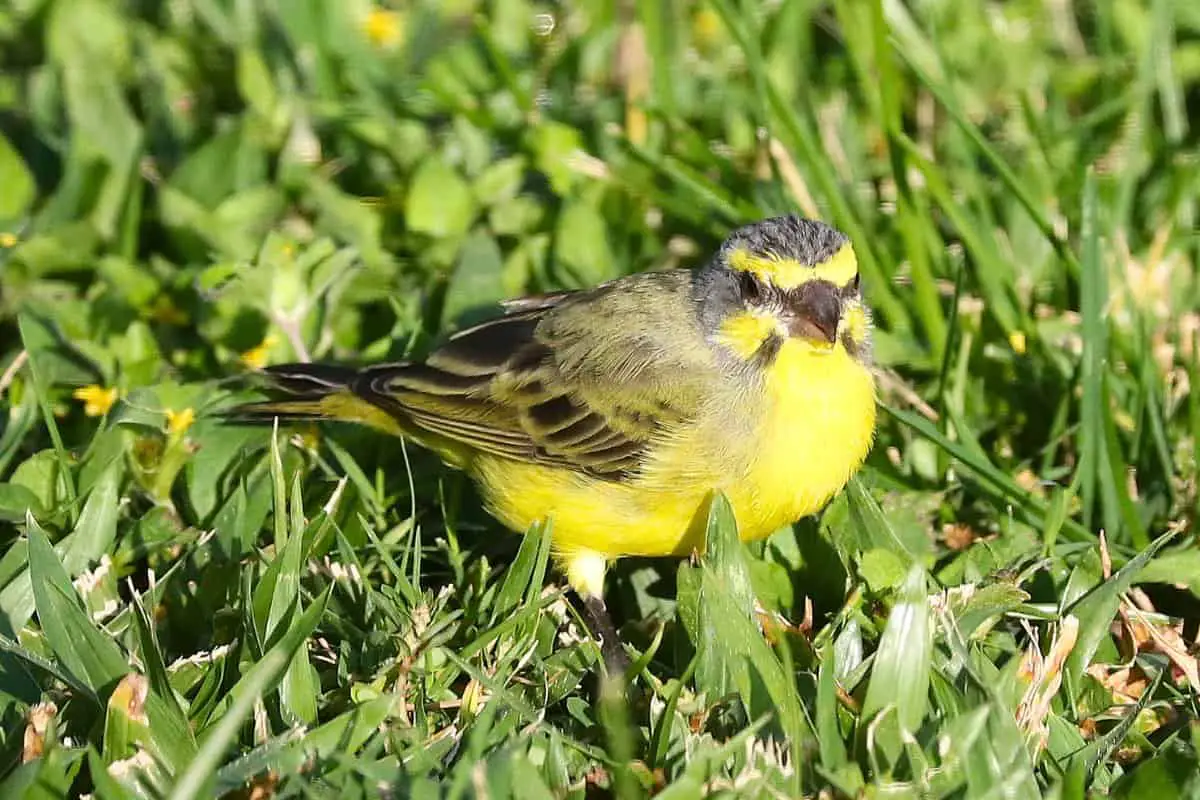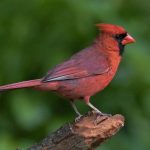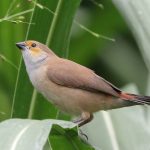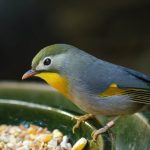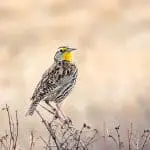Common Name: Yellow-fronted Canary
Scientific Name: (Crithagra mozambica)| Size | Diet | Range in Hawaii | Status in Hawaii |
|---|---|---|---|
| 4.5 in. - 5.5 in. | nectar and seeds | O'ahu and Big Island | Least Concern |
The Yellow-fronted Canary (Crithagra mozambica) is a charming and vibrant bird species that is known for its striking yellow and green plumage and melodious singing. Originally from Africa, this canary has recently established itself as a naturalized (non-native) resident in Hawaii, where it has become a beloved sight among birdwatchers.
In this article, we’ll explore the fascinating world of the Yellow-fronted Canary, its unique adaptations, and behavior in the wild.
Yellow-fronted Canary
Appearance

The Yellow-fronted Canary is a delightful avian species that captivates with its vibrant appearance. Adorned with a striking combination of colors, this small passerine bird stands out effortlessly. Its most prominent feature is its brilliant yellow head, enhanced by its dark, beady eyes that seem to twinkle with curiosity.
Measuring around 4.5 to 5.5 inches (11 to 14 centimeters) in length, the Yellow-fronted Canary possesses a compact yet elegant physique. Its sleek body is complemented by a slender, pointed beak that aids in foraging for food.
With its distinct coloration, the bird boasts a rich yellow belly and breast, transitioning into a beautiful olive-green hue along its wings and back. This captivating color palette creates a visually stunning contrast, accentuating the bird’s charm.
Diet
In the wild, the Yellow-fronted Canary primarily feeds on seeds, making it classified as a granivorous bird. It possesses a strong beak specifically adapted for cracking open the tough outer shells of various seeds. This includes a preference for grass seeds, as well as those from herbaceous plants, shrubs, and even trees.
However, the Yellow-fronted Canary’s diet extends beyond seeds. It also shows a fondness for consuming small insects and their larvae. Additionally, the Yellow-fronted Canary may occasionally incorporate fruits and nectar into its diet, particularly during certain seasons when these food sources are abundant.
Nesting
Yellow-fronted Canaries typically construct their nests in trees or shrubs, carefully selecting a concealed and well-protected location. The female takes the lead in building the nest, utilizing a combination of grasses, plant fibers, and other soft materials. She meticulously weaves and shapes these materials into a compact cup-like structure, ensuring stability and comfort for the upcoming brood.
One interesting aspect of their nesting behavior is their fondness for lining the interior of the nest with fine feathers or plant down. This additional layer provides insulation, ensuring a cozy environment for the eggs and later the hatchlings. The female takes great care in selecting and arranging these soft linings, creating a safe and warm nursery for her young.
Once the nest is complete, the female lays a clutch of typically three to five small, pale blue eggs. She diligently incubates the eggs, taking turns with the male to ensure their warmth and protection. This shared responsibility strengthens the bond between the pair and contributes to successful breeding.
After an incubation period of around 12 to 14 days, the eggs hatch, and the nest becomes a bustling hub of activity. Both parents actively feed the hungry nestlings with a combination of regurgitated seeds and insects. This nutritious diet promotes rapid growth and development.
Within a few weeks, the fledglings gain strength and are ready to leave the nest. However, the parents continue to care for them, teaching them essential skills such as foraging and recognizing potential dangers. This post-nesting period is crucial for the young Yellow-fronted Canaries to gain independence and learn survival strategies.
Behavior
One notable behavior of the Yellow-fronted Canary is its delightful and melodious song. Males, in particular, are known for their tuneful vocalizations, which they use to establish territory and attract mates. Their songs are a delightful blend of cheerful chirps and trills, often accompanied by vibrant displays of fluttering wings and animated movements.
Yellow-fronted Canaries are also highly sociable creatures, often forming small flocks with other individuals of their species. These flocks can be seen foraging together, communicating through a series of soft calls and chirps. This social behavior not only promotes safety in numbers but also allows for cooperative foraging and the sharing of valuable information about food sources and potential threats.
In addition to their social nature, Yellow-fronted Canaries are agile and acrobatic in their movements. They are skilled at hopping and flitting between branches and foliage as they search for food or explore their surroundings. Their nimble nature enables them to access various food sources and seek shelter when needed.
During the breeding season, the behavior of Yellow-fronted Canaries becomes even more fascinating. Males engage in vibrant courtship displays, showcasing their bright yellow plumage and performing elaborate flight patterns to impress females. These displays often involve fluttering flights, accompanied by melodious songs and eye-catching displays of their distinctive colors.
Another interesting behavior observed in Yellow-fronted Canaries is their diligent nest-building and parental care. The females take the lead in constructing intricate nests, while both parents share the responsibility of incubating the eggs and feeding the hatchlings. This cooperative approach ensures the well-being and survival of their offspring.
Habitat
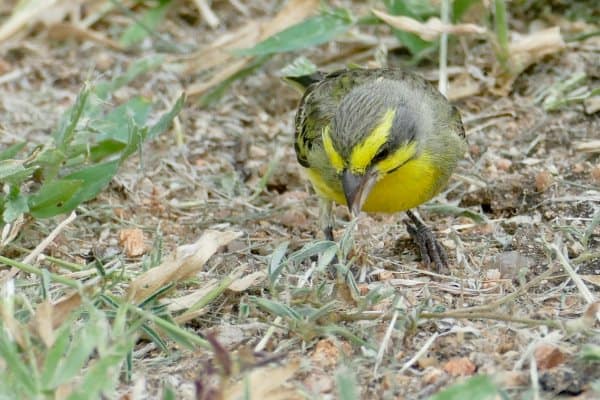
The Yellow-fronted Canary thrives in diverse habitats across sub-Saharan Africa. It can be found in open grasslands, savannas, woodland edges, scrublands, agricultural fields, gardens, and near water sources like rivers and wetlands.
Range
The Yellow-fronted Canary (Crithagra mozambica) is a naturalized (non-native) resident in Hawaii. It was introduced to the Southeastern Hawaiian Islands in the mid-1960s and has since become established in dry habitats on O’ahu and Hawai’i.
Initially observed in the Diamond Head area, the population slowly expanded to other regions of O’ahu, including downtown Honolulu and Pearl Harbor. On Hawai’i Island, the canaries were first observed at Pu’u Wa’a Wa’a Ranch and later spread along the slopes of Mauna Kea and Mt Hualalai.
Conservation Status
According to the International Union for Conservation of Nature (IUCN), the Yellow-fronted Canary (Crithagra mozambica) is currently assessed as a species of “Least Concern” (LC). This designation indicates that the overall population of the species is stable, and it is not currently facing significant threats that would necessitate a higher conservation status.
Interesting Facts
1. Mimicking abilities
Yellow-fronted Canaries have been known to mimic the songs of other bird species, showcasing their impressive vocal abilities and adaptability.
2. Nomadic movements
In certain regions, the Yellow-fronted Canary displays nomadic behavior, meaning that its movements can be irregular and influenced by food availability and environmental conditions.
3. Hybridization
The Yellow-fronted Canary is known to hybridize with other canary species, such as the Brimstone Canary (Crithagra sulphurata). This hybridization can lead to interesting variations in plumage and behavior.
4. Avicultural popularity
Due to their vibrant colors and melodious songs, Yellow-fronted Canaries are popular among aviculture enthusiasts. They are often kept as pets or bred in captivity for their beauty and singing abilities.
5. Cultural significance
The Yellow-fronted Canary holds cultural significance in some African communities, where its vibrant colors and cheerful songs are celebrated and admired as symbols of joy and happiness.
Frequently Asked Questions
1. How can I attract Yellow-fronted Canaries to my garden?
To attract Yellow-fronted Canaries to your garden, you can provide a variety of bird-friendly plants that produce seeds and offer cover. Additionally, offering bird feeders with a mix of seeds and fresh water can entice them to visit.
2. How long do Yellow-fronted Canaries live?
On average, Yellow-fronted Canaries have a lifespan of about 5 to 8 years in the wild. However, with proper care, captive individuals can live up to 10 years or more.
3. Can Yellow-fronted Canaries be kept with other bird species?
Yellow-fronted Canaries are generally peaceful and can be kept with other small, non-aggressive bird species. However, it’s important to ensure compatibility and provide adequate space and resources for all the birds.
4. Can Yellow-fronted Canaries learn to mimic human speech?
While Yellow-fronted Canaries are not known for their ability to mimic human speech, they are primarily known for mimicking the songs of other bird species.
